Case Study of a 68-Year Old Adult with Obesity
VerifiedAdded on 2022/11/26
|9
|2154
|138
AI Summary
This case study examines the health complications and interventions for a 68-year old adult with obesity. Learn about BMI, nutrition, exercise, and recommended interventions.
Contribute Materials
Your contribution can guide someone’s learning journey. Share your
documents today.
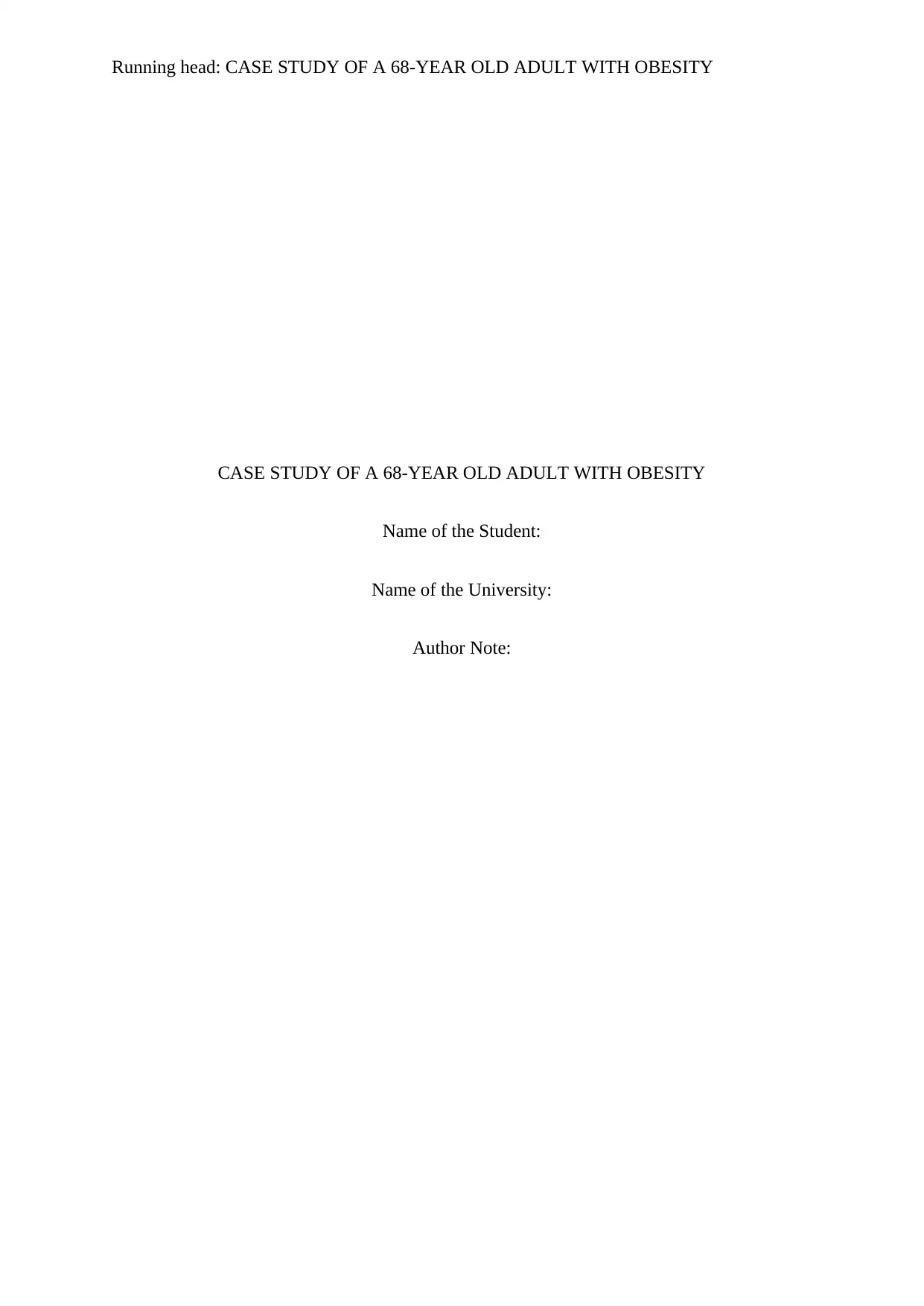
Running head: CASE STUDY OF A 68-YEAR OLD ADULT WITH OBESITY
CASE STUDY OF A 68-YEAR OLD ADULT WITH OBESITY
Name of the Student:
Name of the University:
Author Note:
CASE STUDY OF A 68-YEAR OLD ADULT WITH OBESITY
Name of the Student:
Name of the University:
Author Note:
Secure Best Marks with AI Grader
Need help grading? Try our AI Grader for instant feedback on your assignments.
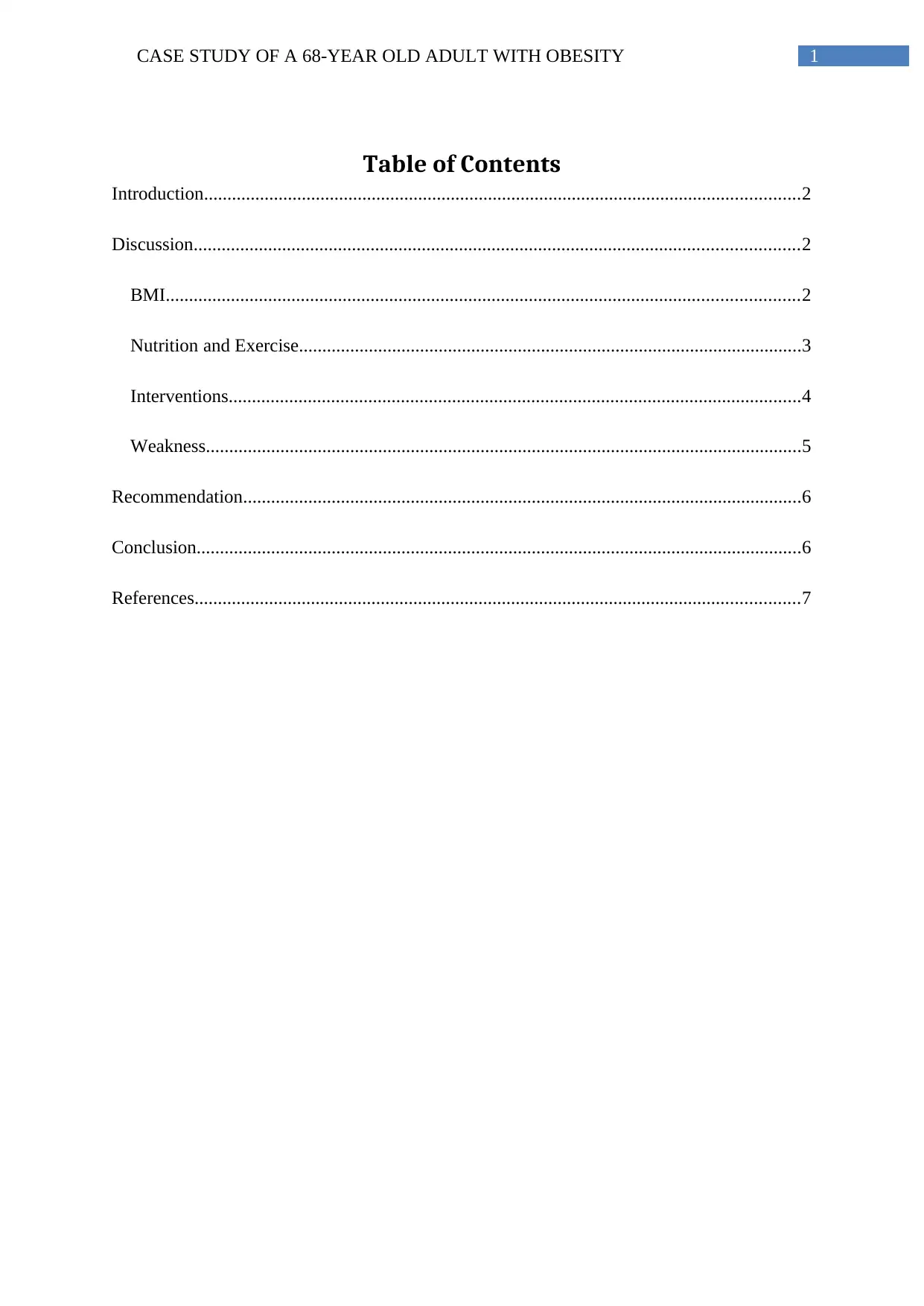
1CASE STUDY OF A 68-YEAR OLD ADULT WITH OBESITY
Table of Contents
Introduction................................................................................................................................2
Discussion..................................................................................................................................2
BMI........................................................................................................................................2
Nutrition and Exercise............................................................................................................3
Interventions...........................................................................................................................4
Weakness................................................................................................................................5
Recommendation........................................................................................................................6
Conclusion..................................................................................................................................6
References..................................................................................................................................7
Table of Contents
Introduction................................................................................................................................2
Discussion..................................................................................................................................2
BMI........................................................................................................................................2
Nutrition and Exercise............................................................................................................3
Interventions...........................................................................................................................4
Weakness................................................................................................................................5
Recommendation........................................................................................................................6
Conclusion..................................................................................................................................6
References..................................................................................................................................7
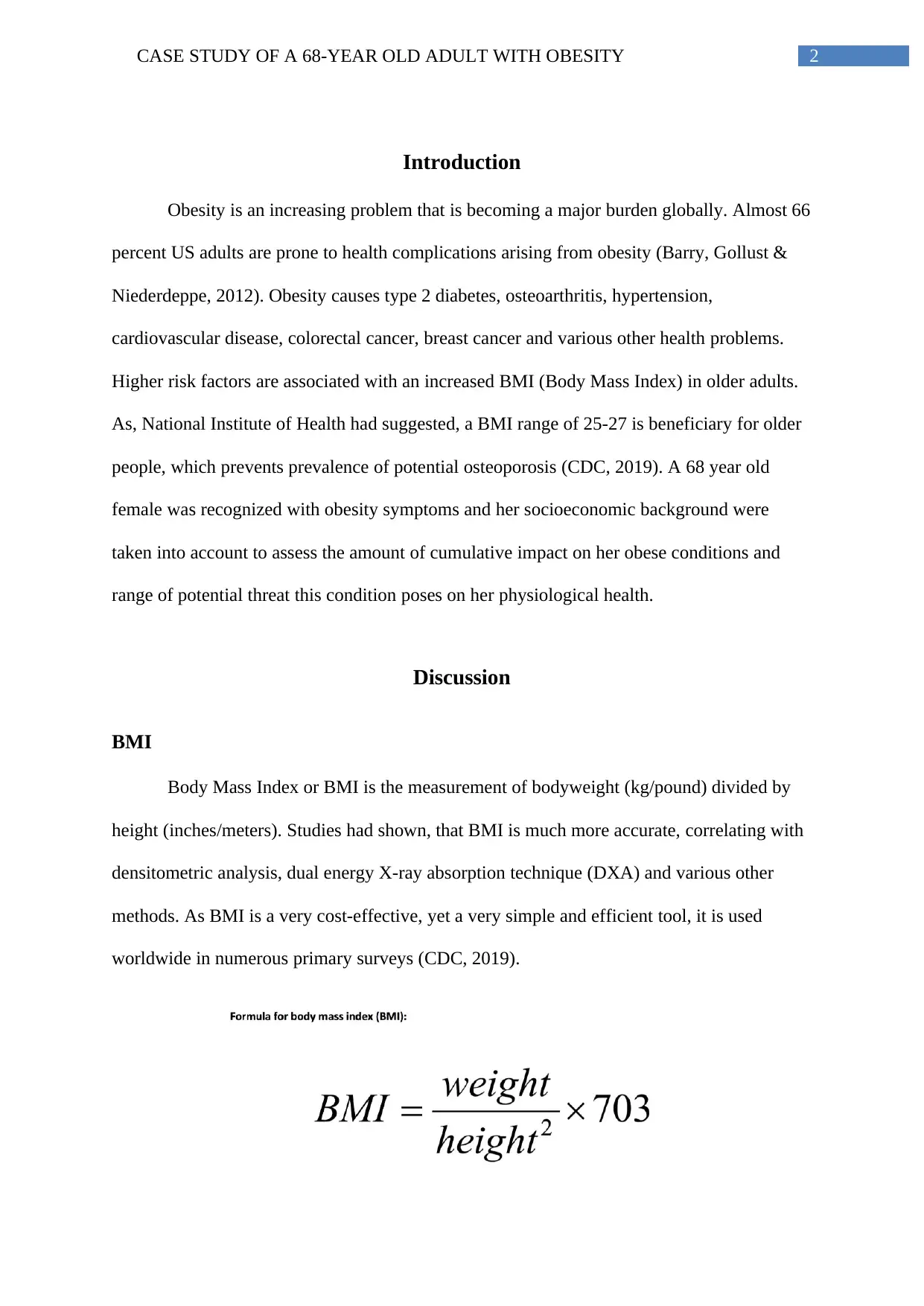
2CASE STUDY OF A 68-YEAR OLD ADULT WITH OBESITY
Introduction
Obesity is an increasing problem that is becoming a major burden globally. Almost 66
percent US adults are prone to health complications arising from obesity (Barry, Gollust &
Niederdeppe, 2012). Obesity causes type 2 diabetes, osteoarthritis, hypertension,
cardiovascular disease, colorectal cancer, breast cancer and various other health problems.
Higher risk factors are associated with an increased BMI (Body Mass Index) in older adults.
As, National Institute of Health had suggested, a BMI range of 25-27 is beneficiary for older
people, which prevents prevalence of potential osteoporosis (CDC, 2019). A 68 year old
female was recognized with obesity symptoms and her socioeconomic background were
taken into account to assess the amount of cumulative impact on her obese conditions and
range of potential threat this condition poses on her physiological health.
Discussion
BMI
Body Mass Index or BMI is the measurement of bodyweight (kg/pound) divided by
height (inches/meters). Studies had shown, that BMI is much more accurate, correlating with
densitometric analysis, dual energy X-ray absorption technique (DXA) and various other
methods. As BMI is a very cost-effective, yet a very simple and efficient tool, it is used
worldwide in numerous primary surveys (CDC, 2019).
Introduction
Obesity is an increasing problem that is becoming a major burden globally. Almost 66
percent US adults are prone to health complications arising from obesity (Barry, Gollust &
Niederdeppe, 2012). Obesity causes type 2 diabetes, osteoarthritis, hypertension,
cardiovascular disease, colorectal cancer, breast cancer and various other health problems.
Higher risk factors are associated with an increased BMI (Body Mass Index) in older adults.
As, National Institute of Health had suggested, a BMI range of 25-27 is beneficiary for older
people, which prevents prevalence of potential osteoporosis (CDC, 2019). A 68 year old
female was recognized with obesity symptoms and her socioeconomic background were
taken into account to assess the amount of cumulative impact on her obese conditions and
range of potential threat this condition poses on her physiological health.
Discussion
BMI
Body Mass Index or BMI is the measurement of bodyweight (kg/pound) divided by
height (inches/meters). Studies had shown, that BMI is much more accurate, correlating with
densitometric analysis, dual energy X-ray absorption technique (DXA) and various other
methods. As BMI is a very cost-effective, yet a very simple and efficient tool, it is used
worldwide in numerous primary surveys (CDC, 2019).
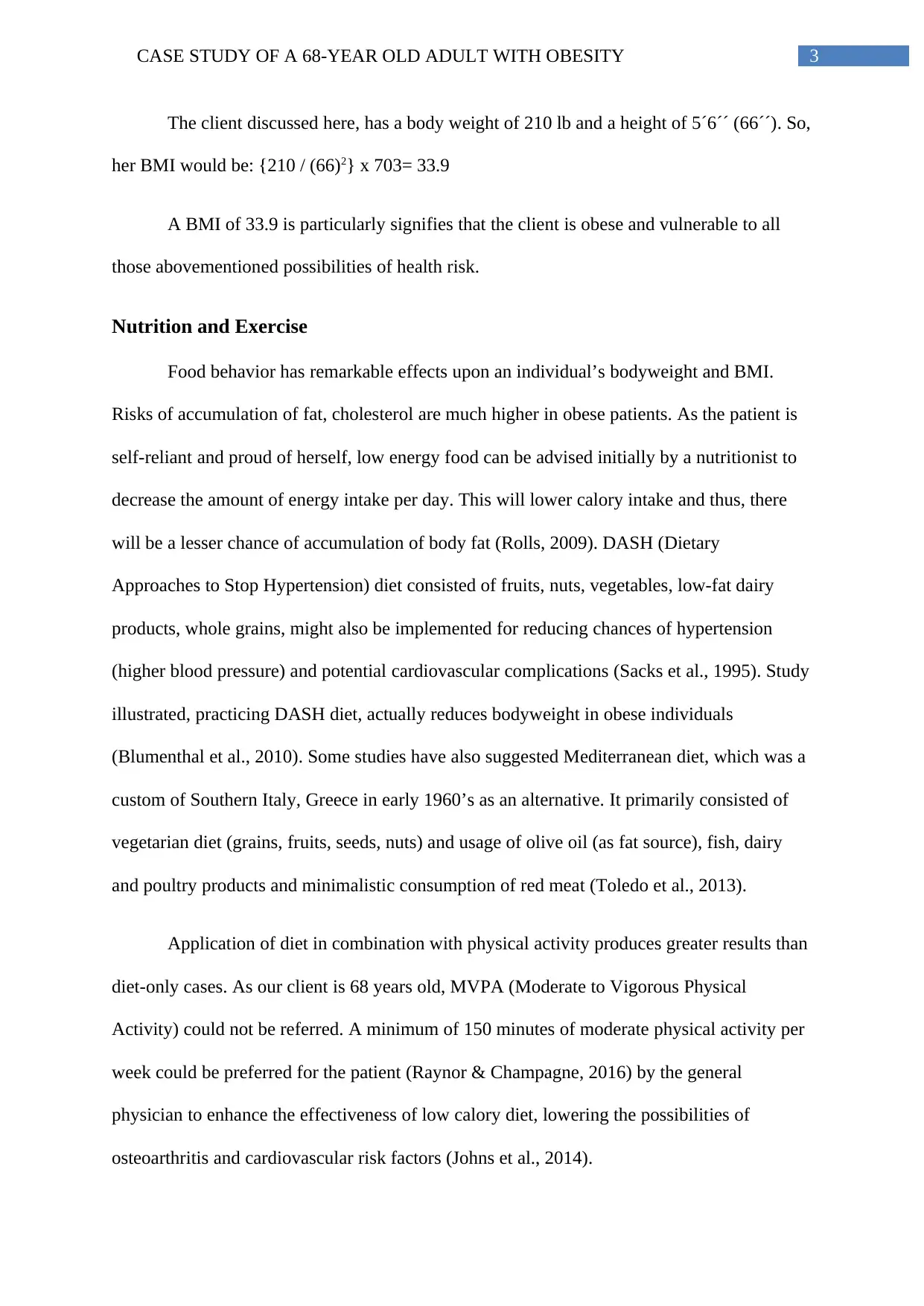
3CASE STUDY OF A 68-YEAR OLD ADULT WITH OBESITY
The client discussed here, has a body weight of 210 lb and a height of 5ˊ6ˊˊ (66ˊˊ). So,
her BMI would be: {210 / (66)2} x 703= 33.9
A BMI of 33.9 is particularly signifies that the client is obese and vulnerable to all
those abovementioned possibilities of health risk.
Nutrition and Exercise
Food behavior has remarkable effects upon an individual’s bodyweight and BMI.
Risks of accumulation of fat, cholesterol are much higher in obese patients. As the patient is
self-reliant and proud of herself, low energy food can be advised initially by a nutritionist to
decrease the amount of energy intake per day. This will lower calory intake and thus, there
will be a lesser chance of accumulation of body fat (Rolls, 2009). DASH (Dietary
Approaches to Stop Hypertension) diet consisted of fruits, nuts, vegetables, low-fat dairy
products, whole grains, might also be implemented for reducing chances of hypertension
(higher blood pressure) and potential cardiovascular complications (Sacks et al., 1995). Study
illustrated, practicing DASH diet, actually reduces bodyweight in obese individuals
(Blumenthal et al., 2010). Some studies have also suggested Mediterranean diet, which was a
custom of Southern Italy, Greece in early 1960’s as an alternative. It primarily consisted of
vegetarian diet (grains, fruits, seeds, nuts) and usage of olive oil (as fat source), fish, dairy
and poultry products and minimalistic consumption of red meat (Toledo et al., 2013).
Application of diet in combination with physical activity produces greater results than
diet-only cases. As our client is 68 years old, MVPA (Moderate to Vigorous Physical
Activity) could not be referred. A minimum of 150 minutes of moderate physical activity per
week could be preferred for the patient (Raynor & Champagne, 2016) by the general
physician to enhance the effectiveness of low calory diet, lowering the possibilities of
osteoarthritis and cardiovascular risk factors (Johns et al., 2014).
The client discussed here, has a body weight of 210 lb and a height of 5ˊ6ˊˊ (66ˊˊ). So,
her BMI would be: {210 / (66)2} x 703= 33.9
A BMI of 33.9 is particularly signifies that the client is obese and vulnerable to all
those abovementioned possibilities of health risk.
Nutrition and Exercise
Food behavior has remarkable effects upon an individual’s bodyweight and BMI.
Risks of accumulation of fat, cholesterol are much higher in obese patients. As the patient is
self-reliant and proud of herself, low energy food can be advised initially by a nutritionist to
decrease the amount of energy intake per day. This will lower calory intake and thus, there
will be a lesser chance of accumulation of body fat (Rolls, 2009). DASH (Dietary
Approaches to Stop Hypertension) diet consisted of fruits, nuts, vegetables, low-fat dairy
products, whole grains, might also be implemented for reducing chances of hypertension
(higher blood pressure) and potential cardiovascular complications (Sacks et al., 1995). Study
illustrated, practicing DASH diet, actually reduces bodyweight in obese individuals
(Blumenthal et al., 2010). Some studies have also suggested Mediterranean diet, which was a
custom of Southern Italy, Greece in early 1960’s as an alternative. It primarily consisted of
vegetarian diet (grains, fruits, seeds, nuts) and usage of olive oil (as fat source), fish, dairy
and poultry products and minimalistic consumption of red meat (Toledo et al., 2013).
Application of diet in combination with physical activity produces greater results than
diet-only cases. As our client is 68 years old, MVPA (Moderate to Vigorous Physical
Activity) could not be referred. A minimum of 150 minutes of moderate physical activity per
week could be preferred for the patient (Raynor & Champagne, 2016) by the general
physician to enhance the effectiveness of low calory diet, lowering the possibilities of
osteoarthritis and cardiovascular risk factors (Johns et al., 2014).
Secure Best Marks with AI Grader
Need help grading? Try our AI Grader for instant feedback on your assignments.
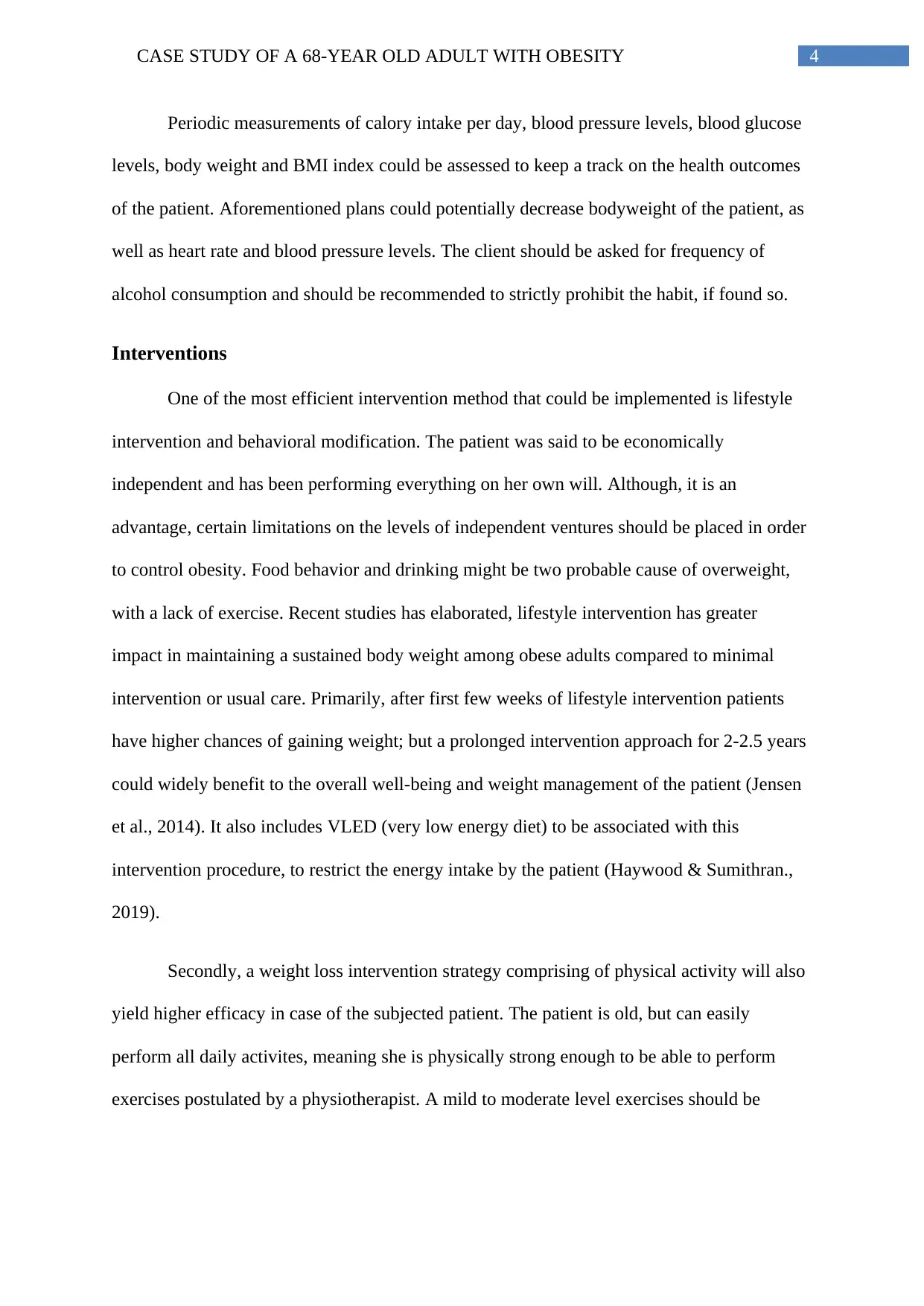
4CASE STUDY OF A 68-YEAR OLD ADULT WITH OBESITY
Periodic measurements of calory intake per day, blood pressure levels, blood glucose
levels, body weight and BMI index could be assessed to keep a track on the health outcomes
of the patient. Aforementioned plans could potentially decrease bodyweight of the patient, as
well as heart rate and blood pressure levels. The client should be asked for frequency of
alcohol consumption and should be recommended to strictly prohibit the habit, if found so.
Interventions
One of the most efficient intervention method that could be implemented is lifestyle
intervention and behavioral modification. The patient was said to be economically
independent and has been performing everything on her own will. Although, it is an
advantage, certain limitations on the levels of independent ventures should be placed in order
to control obesity. Food behavior and drinking might be two probable cause of overweight,
with a lack of exercise. Recent studies has elaborated, lifestyle intervention has greater
impact in maintaining a sustained body weight among obese adults compared to minimal
intervention or usual care. Primarily, after first few weeks of lifestyle intervention patients
have higher chances of gaining weight; but a prolonged intervention approach for 2-2.5 years
could widely benefit to the overall well-being and weight management of the patient (Jensen
et al., 2014). It also includes VLED (very low energy diet) to be associated with this
intervention procedure, to restrict the energy intake by the patient (Haywood & Sumithran.,
2019).
Secondly, a weight loss intervention strategy comprising of physical activity will also
yield higher efficacy in case of the subjected patient. The patient is old, but can easily
perform all daily activites, meaning she is physically strong enough to be able to perform
exercises postulated by a physiotherapist. A mild to moderate level exercises should be
Periodic measurements of calory intake per day, blood pressure levels, blood glucose
levels, body weight and BMI index could be assessed to keep a track on the health outcomes
of the patient. Aforementioned plans could potentially decrease bodyweight of the patient, as
well as heart rate and blood pressure levels. The client should be asked for frequency of
alcohol consumption and should be recommended to strictly prohibit the habit, if found so.
Interventions
One of the most efficient intervention method that could be implemented is lifestyle
intervention and behavioral modification. The patient was said to be economically
independent and has been performing everything on her own will. Although, it is an
advantage, certain limitations on the levels of independent ventures should be placed in order
to control obesity. Food behavior and drinking might be two probable cause of overweight,
with a lack of exercise. Recent studies has elaborated, lifestyle intervention has greater
impact in maintaining a sustained body weight among obese adults compared to minimal
intervention or usual care. Primarily, after first few weeks of lifestyle intervention patients
have higher chances of gaining weight; but a prolonged intervention approach for 2-2.5 years
could widely benefit to the overall well-being and weight management of the patient (Jensen
et al., 2014). It also includes VLED (very low energy diet) to be associated with this
intervention procedure, to restrict the energy intake by the patient (Haywood & Sumithran.,
2019).
Secondly, a weight loss intervention strategy comprising of physical activity will also
yield higher efficacy in case of the subjected patient. The patient is old, but can easily
perform all daily activites, meaning she is physically strong enough to be able to perform
exercises postulated by a physiotherapist. A mild to moderate level exercises should be
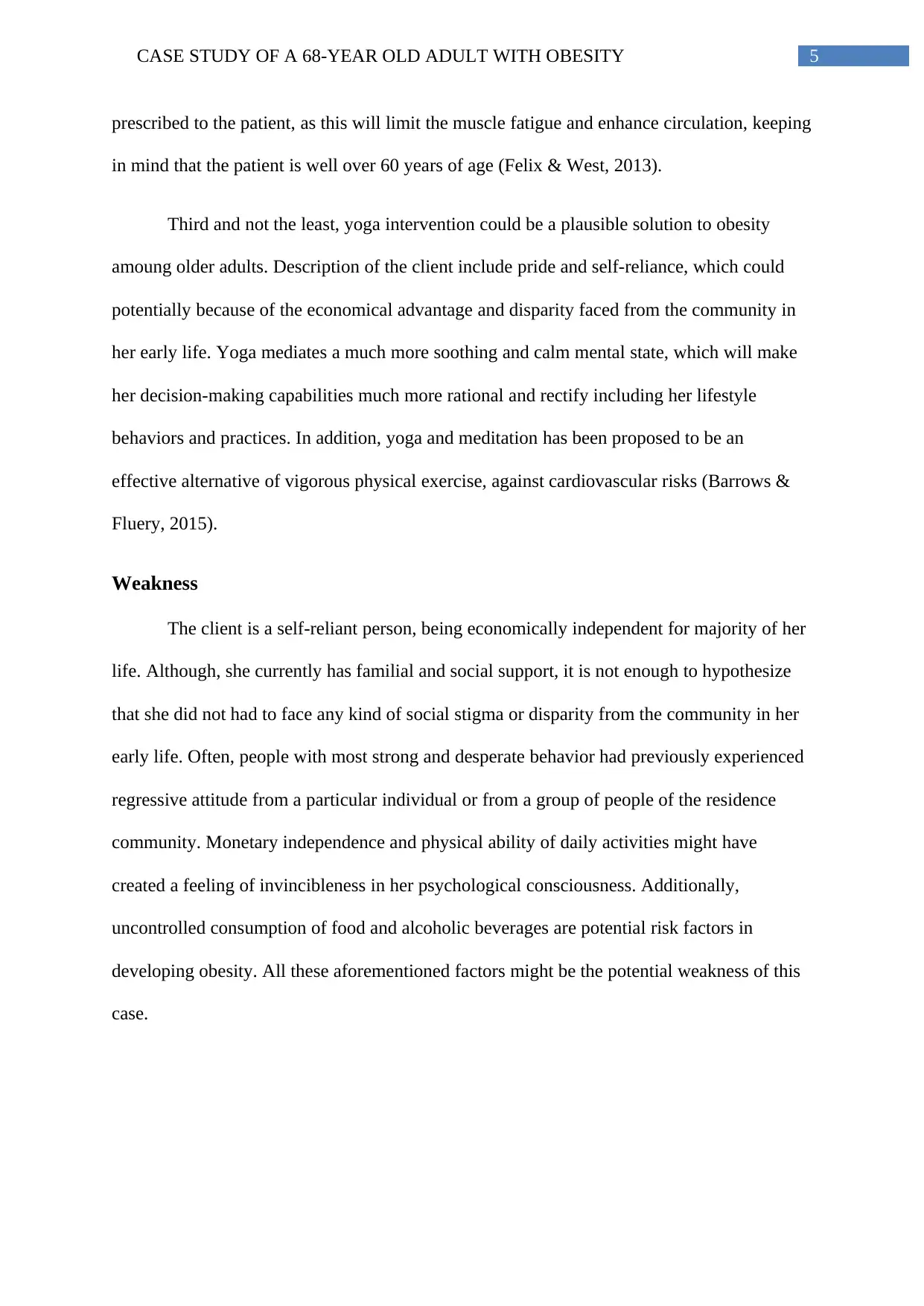
5CASE STUDY OF A 68-YEAR OLD ADULT WITH OBESITY
prescribed to the patient, as this will limit the muscle fatigue and enhance circulation, keeping
in mind that the patient is well over 60 years of age (Felix & West, 2013).
Third and not the least, yoga intervention could be a plausible solution to obesity
amoung older adults. Description of the client include pride and self-reliance, which could
potentially because of the economical advantage and disparity faced from the community in
her early life. Yoga mediates a much more soothing and calm mental state, which will make
her decision-making capabilities much more rational and rectify including her lifestyle
behaviors and practices. In addition, yoga and meditation has been proposed to be an
effective alternative of vigorous physical exercise, against cardiovascular risks (Barrows &
Fluery, 2015).
Weakness
The client is a self-reliant person, being economically independent for majority of her
life. Although, she currently has familial and social support, it is not enough to hypothesize
that she did not had to face any kind of social stigma or disparity from the community in her
early life. Often, people with most strong and desperate behavior had previously experienced
regressive attitude from a particular individual or from a group of people of the residence
community. Monetary independence and physical ability of daily activities might have
created a feeling of invincibleness in her psychological consciousness. Additionally,
uncontrolled consumption of food and alcoholic beverages are potential risk factors in
developing obesity. All these aforementioned factors might be the potential weakness of this
case.
prescribed to the patient, as this will limit the muscle fatigue and enhance circulation, keeping
in mind that the patient is well over 60 years of age (Felix & West, 2013).
Third and not the least, yoga intervention could be a plausible solution to obesity
amoung older adults. Description of the client include pride and self-reliance, which could
potentially because of the economical advantage and disparity faced from the community in
her early life. Yoga mediates a much more soothing and calm mental state, which will make
her decision-making capabilities much more rational and rectify including her lifestyle
behaviors and practices. In addition, yoga and meditation has been proposed to be an
effective alternative of vigorous physical exercise, against cardiovascular risks (Barrows &
Fluery, 2015).
Weakness
The client is a self-reliant person, being economically independent for majority of her
life. Although, she currently has familial and social support, it is not enough to hypothesize
that she did not had to face any kind of social stigma or disparity from the community in her
early life. Often, people with most strong and desperate behavior had previously experienced
regressive attitude from a particular individual or from a group of people of the residence
community. Monetary independence and physical ability of daily activities might have
created a feeling of invincibleness in her psychological consciousness. Additionally,
uncontrolled consumption of food and alcoholic beverages are potential risk factors in
developing obesity. All these aforementioned factors might be the potential weakness of this
case.
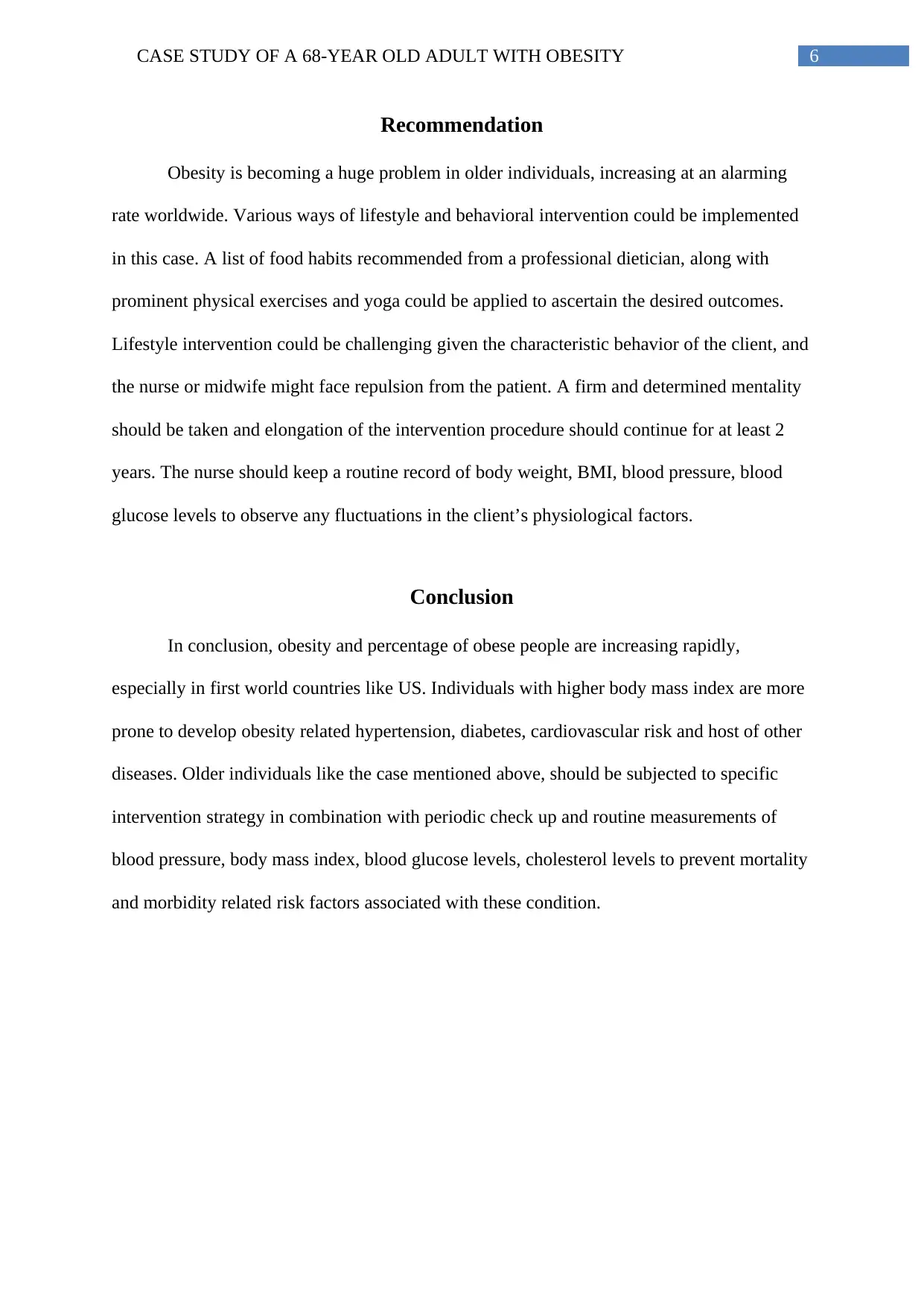
6CASE STUDY OF A 68-YEAR OLD ADULT WITH OBESITY
Recommendation
Obesity is becoming a huge problem in older individuals, increasing at an alarming
rate worldwide. Various ways of lifestyle and behavioral intervention could be implemented
in this case. A list of food habits recommended from a professional dietician, along with
prominent physical exercises and yoga could be applied to ascertain the desired outcomes.
Lifestyle intervention could be challenging given the characteristic behavior of the client, and
the nurse or midwife might face repulsion from the patient. A firm and determined mentality
should be taken and elongation of the intervention procedure should continue for at least 2
years. The nurse should keep a routine record of body weight, BMI, blood pressure, blood
glucose levels to observe any fluctuations in the client’s physiological factors.
Conclusion
In conclusion, obesity and percentage of obese people are increasing rapidly,
especially in first world countries like US. Individuals with higher body mass index are more
prone to develop obesity related hypertension, diabetes, cardiovascular risk and host of other
diseases. Older individuals like the case mentioned above, should be subjected to specific
intervention strategy in combination with periodic check up and routine measurements of
blood pressure, body mass index, blood glucose levels, cholesterol levels to prevent mortality
and morbidity related risk factors associated with these condition.
Recommendation
Obesity is becoming a huge problem in older individuals, increasing at an alarming
rate worldwide. Various ways of lifestyle and behavioral intervention could be implemented
in this case. A list of food habits recommended from a professional dietician, along with
prominent physical exercises and yoga could be applied to ascertain the desired outcomes.
Lifestyle intervention could be challenging given the characteristic behavior of the client, and
the nurse or midwife might face repulsion from the patient. A firm and determined mentality
should be taken and elongation of the intervention procedure should continue for at least 2
years. The nurse should keep a routine record of body weight, BMI, blood pressure, blood
glucose levels to observe any fluctuations in the client’s physiological factors.
Conclusion
In conclusion, obesity and percentage of obese people are increasing rapidly,
especially in first world countries like US. Individuals with higher body mass index are more
prone to develop obesity related hypertension, diabetes, cardiovascular risk and host of other
diseases. Older individuals like the case mentioned above, should be subjected to specific
intervention strategy in combination with periodic check up and routine measurements of
blood pressure, body mass index, blood glucose levels, cholesterol levels to prevent mortality
and morbidity related risk factors associated with these condition.
Paraphrase This Document
Need a fresh take? Get an instant paraphrase of this document with our AI Paraphraser
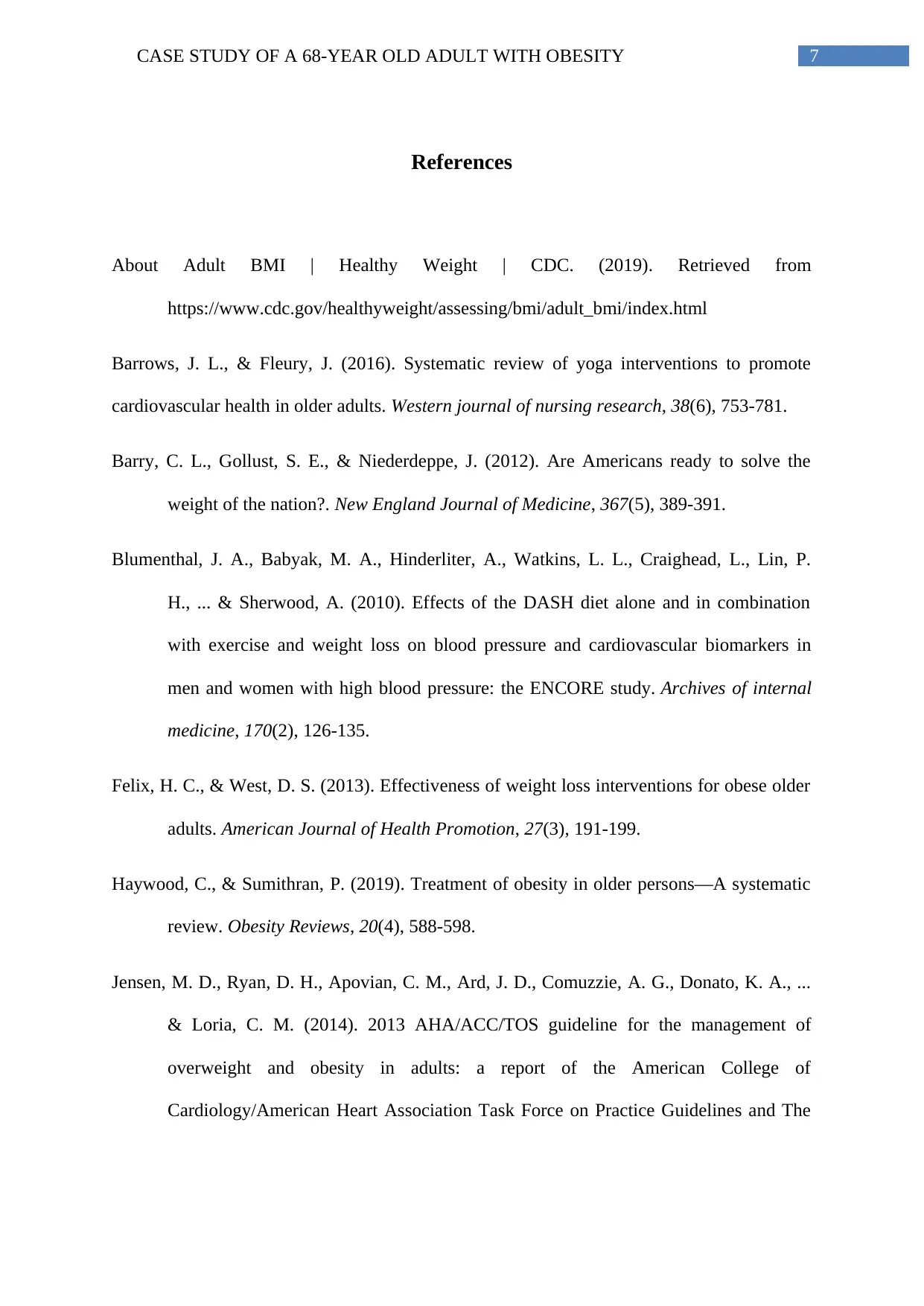
7CASE STUDY OF A 68-YEAR OLD ADULT WITH OBESITY
References
About Adult BMI | Healthy Weight | CDC. (2019). Retrieved from
https://www.cdc.gov/healthyweight/assessing/bmi/adult_bmi/index.html
Barrows, J. L., & Fleury, J. (2016). Systematic review of yoga interventions to promote
cardiovascular health in older adults. Western journal of nursing research, 38(6), 753-781.
Barry, C. L., Gollust, S. E., & Niederdeppe, J. (2012). Are Americans ready to solve the
weight of the nation?. New England Journal of Medicine, 367(5), 389-391.
Blumenthal, J. A., Babyak, M. A., Hinderliter, A., Watkins, L. L., Craighead, L., Lin, P.
H., ... & Sherwood, A. (2010). Effects of the DASH diet alone and in combination
with exercise and weight loss on blood pressure and cardiovascular biomarkers in
men and women with high blood pressure: the ENCORE study. Archives of internal
medicine, 170(2), 126-135.
Felix, H. C., & West, D. S. (2013). Effectiveness of weight loss interventions for obese older
adults. American Journal of Health Promotion, 27(3), 191-199.
Haywood, C., & Sumithran, P. (2019). Treatment of obesity in older persons—A systematic
review. Obesity Reviews, 20(4), 588-598.
Jensen, M. D., Ryan, D. H., Apovian, C. M., Ard, J. D., Comuzzie, A. G., Donato, K. A., ...
& Loria, C. M. (2014). 2013 AHA/ACC/TOS guideline for the management of
overweight and obesity in adults: a report of the American College of
Cardiology/American Heart Association Task Force on Practice Guidelines and The
References
About Adult BMI | Healthy Weight | CDC. (2019). Retrieved from
https://www.cdc.gov/healthyweight/assessing/bmi/adult_bmi/index.html
Barrows, J. L., & Fleury, J. (2016). Systematic review of yoga interventions to promote
cardiovascular health in older adults. Western journal of nursing research, 38(6), 753-781.
Barry, C. L., Gollust, S. E., & Niederdeppe, J. (2012). Are Americans ready to solve the
weight of the nation?. New England Journal of Medicine, 367(5), 389-391.
Blumenthal, J. A., Babyak, M. A., Hinderliter, A., Watkins, L. L., Craighead, L., Lin, P.
H., ... & Sherwood, A. (2010). Effects of the DASH diet alone and in combination
with exercise and weight loss on blood pressure and cardiovascular biomarkers in
men and women with high blood pressure: the ENCORE study. Archives of internal
medicine, 170(2), 126-135.
Felix, H. C., & West, D. S. (2013). Effectiveness of weight loss interventions for obese older
adults. American Journal of Health Promotion, 27(3), 191-199.
Haywood, C., & Sumithran, P. (2019). Treatment of obesity in older persons—A systematic
review. Obesity Reviews, 20(4), 588-598.
Jensen, M. D., Ryan, D. H., Apovian, C. M., Ard, J. D., Comuzzie, A. G., Donato, K. A., ...
& Loria, C. M. (2014). 2013 AHA/ACC/TOS guideline for the management of
overweight and obesity in adults: a report of the American College of
Cardiology/American Heart Association Task Force on Practice Guidelines and The
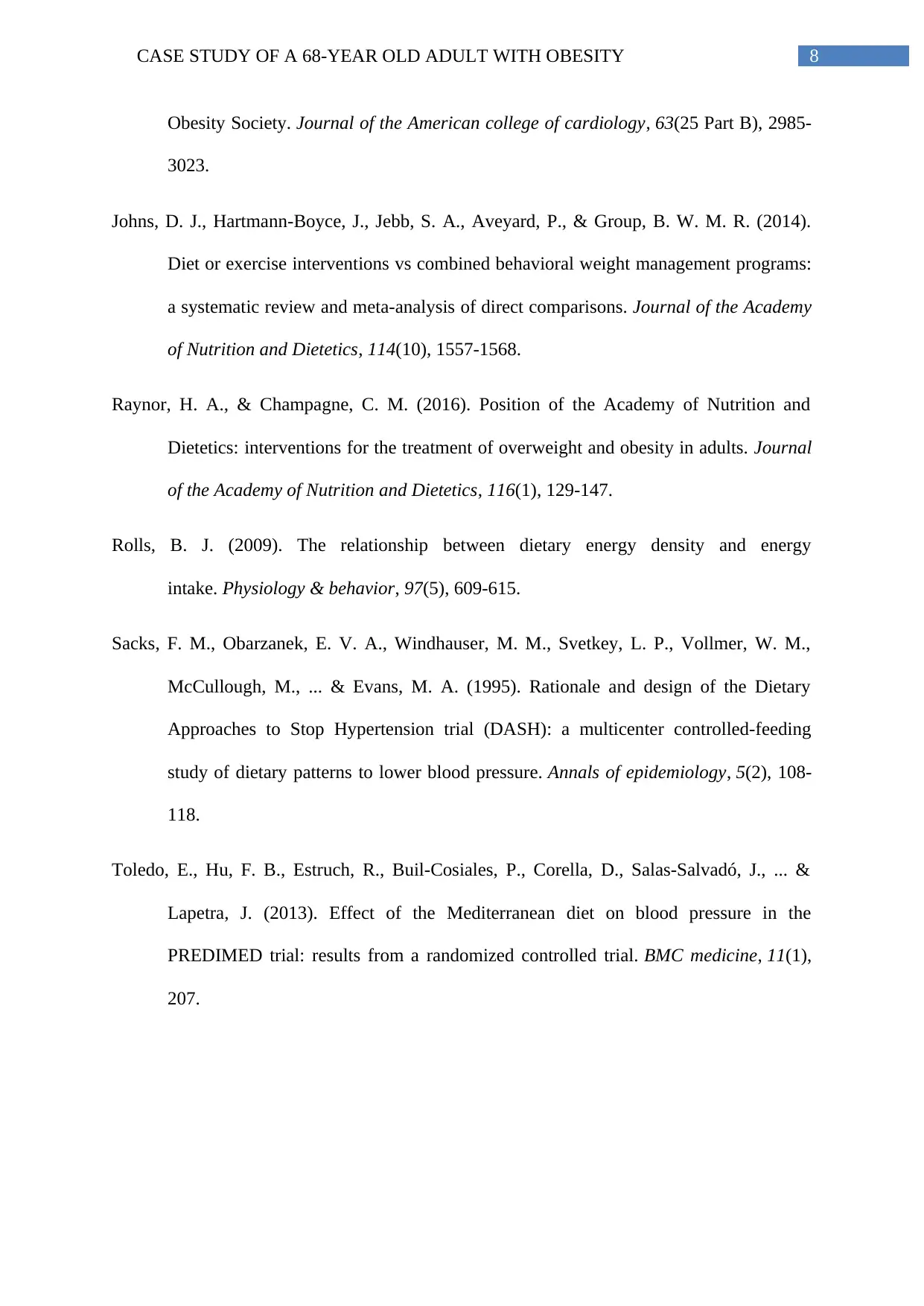
8CASE STUDY OF A 68-YEAR OLD ADULT WITH OBESITY
Obesity Society. Journal of the American college of cardiology, 63(25 Part B), 2985-
3023.
Johns, D. J., Hartmann-Boyce, J., Jebb, S. A., Aveyard, P., & Group, B. W. M. R. (2014).
Diet or exercise interventions vs combined behavioral weight management programs:
a systematic review and meta-analysis of direct comparisons. Journal of the Academy
of Nutrition and Dietetics, 114(10), 1557-1568.
Raynor, H. A., & Champagne, C. M. (2016). Position of the Academy of Nutrition and
Dietetics: interventions for the treatment of overweight and obesity in adults. Journal
of the Academy of Nutrition and Dietetics, 116(1), 129-147.
Rolls, B. J. (2009). The relationship between dietary energy density and energy
intake. Physiology & behavior, 97(5), 609-615.
Sacks, F. M., Obarzanek, E. V. A., Windhauser, M. M., Svetkey, L. P., Vollmer, W. M.,
McCullough, M., ... & Evans, M. A. (1995). Rationale and design of the Dietary
Approaches to Stop Hypertension trial (DASH): a multicenter controlled-feeding
study of dietary patterns to lower blood pressure. Annals of epidemiology, 5(2), 108-
118.
Toledo, E., Hu, F. B., Estruch, R., Buil-Cosiales, P., Corella, D., Salas-Salvadó, J., ... &
Lapetra, J. (2013). Effect of the Mediterranean diet on blood pressure in the
PREDIMED trial: results from a randomized controlled trial. BMC medicine, 11(1),
207.
Obesity Society. Journal of the American college of cardiology, 63(25 Part B), 2985-
3023.
Johns, D. J., Hartmann-Boyce, J., Jebb, S. A., Aveyard, P., & Group, B. W. M. R. (2014).
Diet or exercise interventions vs combined behavioral weight management programs:
a systematic review and meta-analysis of direct comparisons. Journal of the Academy
of Nutrition and Dietetics, 114(10), 1557-1568.
Raynor, H. A., & Champagne, C. M. (2016). Position of the Academy of Nutrition and
Dietetics: interventions for the treatment of overweight and obesity in adults. Journal
of the Academy of Nutrition and Dietetics, 116(1), 129-147.
Rolls, B. J. (2009). The relationship between dietary energy density and energy
intake. Physiology & behavior, 97(5), 609-615.
Sacks, F. M., Obarzanek, E. V. A., Windhauser, M. M., Svetkey, L. P., Vollmer, W. M.,
McCullough, M., ... & Evans, M. A. (1995). Rationale and design of the Dietary
Approaches to Stop Hypertension trial (DASH): a multicenter controlled-feeding
study of dietary patterns to lower blood pressure. Annals of epidemiology, 5(2), 108-
118.
Toledo, E., Hu, F. B., Estruch, R., Buil-Cosiales, P., Corella, D., Salas-Salvadó, J., ... &
Lapetra, J. (2013). Effect of the Mediterranean diet on blood pressure in the
PREDIMED trial: results from a randomized controlled trial. BMC medicine, 11(1),
207.
1 out of 9
Related Documents
Your All-in-One AI-Powered Toolkit for Academic Success.
+13062052269
info@desklib.com
Available 24*7 on WhatsApp / Email
![[object Object]](/_next/static/media/star-bottom.7253800d.svg)
Unlock your academic potential
© 2024 | Zucol Services PVT LTD | All rights reserved.





